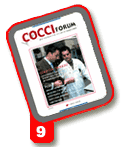COCCI News
Product updates and industry trends

Dr. José Ignacio Barragan
|
The logistics of producing
feed with and without
anticoccidials is sometimes
viewed as a stumbling block
to initiation of coccidiosis vaccination,
but it need not be a
problem, says Dr. José Ignacio
Barragan, poultry veterinarian
an independent nutritional
consultant in Spain.
Let's say a producer wants
to start vaccinating against
coccidiosis on January 1. On
December 30, the feed mill
stops making the F1 or starter feed with the anticoccidial.
Meanwhile, birds prior to that have had the feed with the
anticoccidial for 21 days. By January 20, those birds are 20
days or older.
On January 19, the feed mill produces 1.5 kg (3.31
pounds) of F2 or grower feed for each bird under anticoccidial
control. "This means a minimum of an additional
12 days of consumption. The worst case scenario would be
if the feed mill is able to produce only 1 kg (2.2 pounds)
per bird, which would be additional 8 days of consumption,"
he says.
On January 20, the feed mill produces F2 without anticoccidial
for all the birds that received coccidiosis vaccination.
All birds in the anticoccidial program will have medicated feed for up to a minimum of 33 days and it's unlikely there would be a problem with coccidiosis. As a precaution, the birds could be given amprolium at 35 days "but it probably wouldn't be necessary, Barragan says.
Antibiotic Use in Animals On the Decline, Study Shows
The volume of antibiotics used in the mammoth US animal
health market, including in-feed anticoccidials, dropped
nearly 8% in 2003 compared to 2002, according to a survey of
animal health companies.
In 2003, 8,644,638 pounds of ionophores/arsenicals were used, compared to 9,050,957 pounds in 2002. However, in 2001, only 7,758,492 pounds of these products were used, according to the survey, conducted by the Washington-based Animal Health Association (AHA).
Antibiotics that also were on the decline from 2002 to 2003 included cephalosporins, macrolides, lincosamides and other "minor" classes of antibiotics, as well as aminoglycosides, sulfonamides and penicillins.
The use of fluoroquinolones and tetracyclines increased during the same time period, according to AHA, which says the study included antibiotics used in both farm and companion animals.
Steve Collins, vice president, worldwide poultry for Schering- Plough Animal Health Corporation, says that the study in part reflects public concern about the use of antibiotics in food animals and comes as no surprise considering the dramatic increase in the use of non-antibiotic methods of disease control, such as vaccination for coccidiosis in poultry.
"Seven of the top 10 poultry companies in the United States have used vaccination as part of a long-term, integrated strategy to control coccidiosis in broilers," he notes. "That's a tremendous leap from only a few years ago."
Nevertheless, antibiotics are and will remain an important part of animal health care, he says. "The trend is toward more thoughtful, judicious use of antibiotics in food animals, and that's a positive development."
SprayCox AirMix Technology Simplifies Mixing of Oocysts
 Dr. Mike Francis |
Vaccinating against coccidiosis with the SprayCox spray cabinet
will be even easier with the addition of new AirMix
technology.
AirMix is a simple air pump that keeps the vaccine's oocysts
suspended during mixing, says Paul
Townsend, the tech engineer at
Schering-Plough Animal Health who
developed the original SprayCox and
its latest improvement.
Currently, Coccivac and Paracox
vaccines are mixed in a 10-liter
carboy "a large container "that
is connected to the SprayCox unit
with tubing. A magnetic spin bar
within the carboy mixes the vaccine
solution and is powered by an electric
motor that spins a magnetic bar
underneath the carboy.
However, if the spin bar is thrown off center from the magnetic
stirrer, spinning stops and ooysts fall to the bottom of the
carboy. "This is not detectable except by looking inside the
carboy, which is only done when refilling," Townsend
explains.
To solve the problem, he came up with the idea of using a
small air pump and flexible air diffuser within the carboy. It's
the same device used in aquariums
and emits fine air bubbles that keep
the oocysts suspended, he says.
Testing has indicated that use of the air pump will provide a much more reliable method of mixing the vaccine solution, Townsend says.
This latest improvement comes on the heels of SprayCox II, an updated version of the spray cabinet that features better placement of nozzles. Vaccine spray stays in the box and there is virtually no overspray on the machine or on the floor.
For more information about the new SprayCox design or to upgrade existing equipment, contact your local Schering- Plough Animal Health representative.
Danish Authorities OK Paracox-5 After Rigorous Testing
Schering-Plough Animal Health has secured regulatory
approval to sell its coccidiosis vaccine for broilers,
Paracox-5, in Denmark.
Even though Paracox-5 has been registered throughout the
EU since 2000 and despite significant sales in many of the markets,
the vaccine could not be sold in
Denmark because of testing requirements and
problems unique to that country, explains
Rod Watson, regional senior director for
Europe and the Middle East, Schering-Plough
Animal Health
Denmark has a national screening and eradication program for Newcastle disease virus (NDV) that involves in vivo testing for extraneous agents. The test, however, takes several months to complete, beyond the shelf life of Paracox-5.
Even though all Paracox vaccines are produced in disease-free birds in a GMP plant in an NDV-free country, and even though every single batch is tested for extraneous agents, Danish authorities wanted to abide by the rules of their own program, says Watson.
In addition, if testing according to the Danish program turned up a false positive, then supplies of Paracox-5 could have been delayed throughout Europe, he says.Alternative test
 |
To solve the problem, Schering-Plough Animal Health's regulatory affairs department consulted with the Danish Medicines Agency and concluded that an alternative in vitro test, such as a PCR, could be used in place of the current in vivo test. The company's Research and Development team then came up with a suitable test.
Headed by Dr. Mike Francis, the team started by consulting
with scientists from the Veterinary Laboratories Agency, UK,
which is the European reference laboratory for NDV.
They
developed a plan for an in vitro RP-PCR
test that could detect small amounts of
NDV genetic material within the vaccine.
They also designed bird studies to prove
that this level of antigen could not possibly
lead to seroconversion or active
Newcastle disease in birds vaccinated with
Paracox-5.
After more consultations, the test was
included in the company's standard manufacturing
quality control procedures for
Paracox-5, with a plan to use it as soon as
the Danish authorities accepted the
methodology, he says.
After that, Schering-Plough Animal Health had to validate the suitability of the test, which required more rounds of testing.
One bonus finding was that the sterilization treatment used
to make Paracox-5 would destroy NDV, eliminating the risk of
a bird contacting NDV from the Paracox-5 vaccine, Francis
says.
All the work that was accomplished was compiled into an
audited report and sent with supporting documentation to
Danish regulatory authorities. Within a week after its receipt,
the authorities granted permission to sell Paracox-5 in
Denmark, he says.










